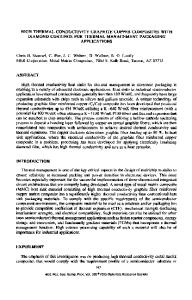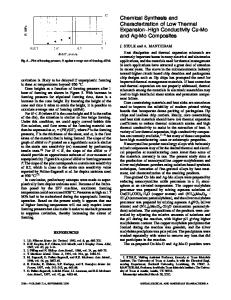Thermal conductivity and thermal expansion of graphite fiber-reinforced copper matrix composites
- PDF / 1,816,640 Bytes
- 10 Pages / 597 x 774 pts Page_size
- 1 Downloads / 375 Views
I.
INTRODUCTION
M A N Y aerospace applications require materials with high thermal conductivity to reduce component operating temperature, extend service life, and reduce system weight. Hypersonic vehicle applications, such as high conductivity heat exchangers, require service lives of hundreds to thousands of hours. They require materials with good elevated temperature tensile and creep strengths, thermal fatigue resistance, and oxidation resistance. The materials for the heat exchangers must be usable at temperatures ranging from 800 K for the cooling channels up to 1200 K for the hot side in the combustor. Space power system applications include high conductivity radiator fins with required service lives of l0 to 30 years. They require high stiffness and low density. The materials for the radiator fins must be usable at temperatures ranging from 300 K for solar power systems up to 1050 K for nuclear power systems. Several materials can be used for high heat flux thermal applications. Copper offers the second best thermal conductivity of the elements, m It is widely available in many forms and can be easily machined and formed. The primary problem with using copper for aerospace applications is its high density (8.92 g/cc), m Copper also suffers from a low yield strength and stiffness, t21 Beryllium is often considered for aerospace applications because of its low density (1.85 g/cc) and high stiffness (303.6 GPa). 131Because of the low density of beryllium, the density-compensated properties are very high. Beryllium suffers from toxicity concerns and product availability. Beryllium also has a maximum use temperature of around 900 K due to a significant decrease in strength above 600 K. t3] While copper and beryllium can be strengthened through alloying to increase their maximum DAVID L. ELLIS, Case Western Reserve University, Cleveland, OH, is a Resident Research Associate at NASA Lewis Research Center, Cleveland, OH. DAVID L. McDANELS, formerly with NASA Lewis Research Center, is retired. This article is based on a presentation made in the symposium "High Performance Copper-Base Materials" as part of the 1991 TMS Annual Meeting, February 17-21, 1991, New Orleans, LA, under the auspices of the TMS Structural Materials Committee. METALLURGICAL TRANSACTIONS A
use temperature, alloying elements significantly lower their thermal conductivity,tal In situ copper composites such as Cu-Nb have high strength at room temperature, but their elevated temperature strength may be degraded by spherodization of the second-phase filaments. The conductivity of the in situ composites is also degraded by the heavy cold working and large volume fraction of the low conductivity second phase. For the hypersonic vehicle and high-temperature radiator fin applications, a material with better elevated temperature strength, such as titanium, niobium, or a superalloy, may be used to meet the mechanical property requirements of the applications. However, these materials suffer from low thermal conductivities and, for the superalloys and n
Data Loading...











